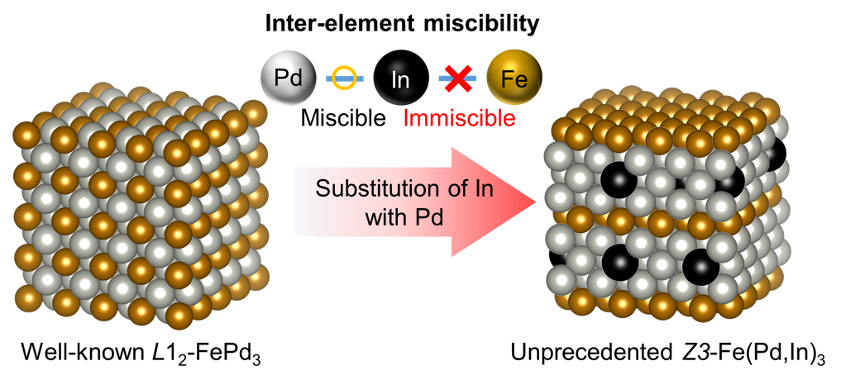Inter-Element Miscibility Driven Stabilization of Ordered Pseudo-Binary Alloy
Published in “Nature Communications” (Online Publication, February 24, 2022).
(Advanced Inorganic Synthesis, Division of Synthetic Chemistry)
Associate Prof. Haruta, M.; Prof. Kurata, H.
(Electron Microscopy and Crystal Chemistry, Advanced Research Center for Beam Science)
Associate Prof. Tatetsu, Y.
(Meio University)
Prof. Yamazoe, S.
(Tokyo Metropolitan University)
Prof. Yamauchi, M.; Assist. Prof. Inagaki, Y.; Dr. Kudo, M.; Mr. Toriyama, T.; Dr. Auchi, M.
(Kyushu University)
Associate Prof. Horibe,Y
(Kyushu Institute of Technology)
Crystal structure of a multicomponent alloy is one of crucial factors for determining physical and chemical properties. A stabilization of metastable structures has been desired for developing novel- or high-functional materials. However, considering the gap between the number of geometrical acceptable and experimental formable structures, there is still room to develop a strategy for stabilizing novel structures.
We succeeded in creating Z3-type Fe(Pd,In)3 phase with the Pd/In/Fe atomic ratio of 63/14/23 via the reductive annealing for nanoparticulate precursor powders, which was the first example of stabilizing Z3-type structure. First-principles calculations strongly supported that the inter-element miscibility of In, which was miscible with Pd but immiscible with Fe, worked as the stabilizer of Z3-type structure. It was also experimentally confirmed by synthesizing Z3-type structure including Pb instead of In with the same miscibility as In with Fe and Pd. Moreover, Z3-type Fe(Pd,In)3 structure shows an almost identical electron densities of states (DOS) as Z3-FePd3 phase, from which it is expected that Z3-type structure stabilized by In possesses the almost original physical and chemical properties.
This idea that a specific inter-element miscibility works as the stabilizer of unprecedented alloy structure enables us not only to create unknown ordered alloy structures in other alloy systems but also to develop novel- or high-functional materials.

 Institute for Chemical Research, Kyoto University
Institute for Chemical Research, Kyoto University International Joint Usage Research Center
International Joint Usage Research Center